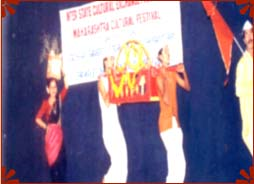 |
The word Lavani derived from Lavanya, meaning beauty. This form is a combination of dance and music, which is dealt with different and varied topics such as society, religion, politics, romance, etc. Attractive women wearing nine-yard saris typically perform the dance with the captivating rhythm of dholak. These women synchronized sensually to a catching tune and teasing lyrics. Maharashtra was once a battle torn state, and Lavana dance served as mode of entertainment and morale booster to the tired soldiers during the 18th and 19th century. The dance reached peak popularity during the Peshwai (a dynasty seated in Pune) rule, when it was given royal support by the ruling elite. Marathi poets like Honaji Bala, Ramjoshi, Prabhakar, etc. took Lavani to new heights. In the recent times, Lavani has become pass, mainly confined to sensual entertainment often presented in a stereotyped and cheap form in Marathi films. |
